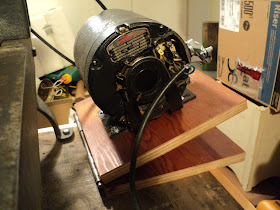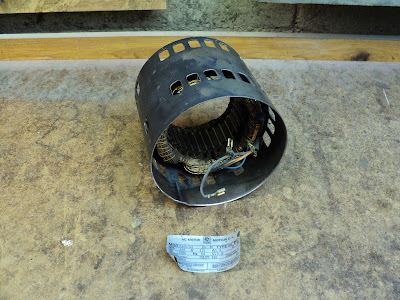It remains to be seen which.
I picked this up by way of Kijiji just recently.
It's a wood-turning lathe that's especially adapted to turning long, slender spindles. It has an extraordinary between-centres length of about 44", and it has a steady-rest. A steady-rest is standard equipment on metal-turning lathes, but it's a rare thing to see on a wood-turning lathe.
There's no manufacturer's name on it anywhere. It may be an off-shore item, but it doesn't have that slipshod off-shore look about it to my eye.
Anyway, I mean to restore this lathe to good-as-new or better condition. That should keep me out of trouble for quite some time.
- - -
A Tour Of The Machine As it Currently Is
The Motor Mount
This is quite a piece of fabrication. It slings the motor underneath the deck, with a lever affair up top that permits v-belt tension to be released for pulley step changes. Here's a view of the thing in its operating position.
And here it is in its tension released position.
I think there may be an easier way to mount the motor, so I won't be reusing this motor mount.
The Deck
The deck is about 18" x 64".
It's made of 1" thick planks, topped with 5/16" firply, edged with 1" x 2" then clad in 7/16" chipboard. It's soaking wet throughout from having been kept outside. Here's a view of it part-way through demolition.
The Legs
The legs are steel weldments made of heavy-gauge angle and flat. They're bolted to the deck by an assortment of 1/4" and 5/16" screws and nuts. The left side leg weldment has two broken welds where the angled bracing flats meet the uprights.
I don't have welding gear, so that will be a challenging problem to deal with. I'm thinking of bolting the brace-ends in place with fabricated steel corner braces. We'll see.
The Lathe Bed And Feet
The bed is two steel channels, 1 3/8" x 2 15/16" x 59 3/4" long, bolted to two identical foot/end castings.
The Headstock
The spindle has a 1" x 8tpi thread on its nose, and an MT2 taper. That's a pretty ordinary configuration for low-end lathes -- the same as on my Delta ShopMaster.
I was told that one of the bearings was running hot. I hope I can salvage the bearings, because they're a double-row, self-aligning type (SKF 1205) that'll likely be costly to replace. We'll see how that goes.
The Tailstock
I think it has an MT2 taper; I haven't tried to knock out the centre yet to find out for sure.
I gave it a shot of WD-40, and the
ram's motion is coming back with a very nice feel to it, so that's encouraging.
The Steady-Rest
It's a big, heavy item
Thankfully, there's not a single piece of it that's missing. I'm looking forward to trying it out.
- - -
So there's an overview of the machine. I'll provide much more detail as I attend to each item.
* * *
The Broken Leg-Brace Welds
As I mentioned earlier, I'm not equipped for welding, so I either have to get welding done for me, or find alternatives to welding when broken welds crop up. Finding alternatives is cheaper, and it affords me complete control of the job, so I'm inclined to find alternatives. Here's what I've come up with for a solution to the broken leg-brace welds.

I fabricated two corner braces from 1/8" thick by 1" wide steel flat, and installed them with 1/4"-20 screws and nuts. Their strength will be more than adequate once the legs are assembled to the deck.
Foot Pads
I thought I'd make the steel legs a little less intensely burdensome on whatever floor they may end up bearing down on, so I made four 3" diameter foot pads from 3/4" plywood with the aid of a fly cutter.
The fasteners are 5/16" x 1 1/4" carriage bolts, counter-bored so their heads sit just below flush with the pads' under-surfaces. I'll sand those properly and paint them Tremclad grey, to match the leg weldments.
Using a fly cutter to make discs like these works remarkably well. The key to it is to reverse the cutter's normal approach orientation, like so.
That way, the cutter breaks through cleanly on the work's outside diameter, instead of on its inside diameter, like it normally does when cutting a hole.
The Motor Mount -- TUESDAY, AUGUST 26, 2014
As I mentioned earlier, I wasn't going to reuse the motor mount that came with the lathe. There's an easier way to accomplish what's needed, and that's to move the motor up behind the headstock, and let gravity do the job of setting the motor's belt-tensioned position. Here's a view of my new motor mount in its operating position.
And here it is in its tension-released position.
Note that the belt is not gravity-tensioned in the sense that gravity is tugging on the belt -- it's not. The belt's tension is set by the motor's at-rest position, which is arrived at via gravity. The distinction is important; actually tensioning a belt by having the motor 'hang' from it is not a good practice.
One improvement I'd like to make to the belt drive is to change to a link-style belt. That would give me a smoother running drive than I'm getting from the stiff, old belt that I scrounged up for this.
Faceplate Fit On The Headstock Spindle's Nose
The 6" faceplate would thread onto the headstock's spindle with a lot of binding; the 1" x 8tpi threads would not run together smoothly at all. The curious thing was that the faceplate would thread onto my Delta lathe ok, and the Delta lathe's 3" faceplate would thread onto this lathe ok, but the combination of old lathe and old faceplate would bind.
I slathered the spindle's nose with valve grinding compound, worked the threads together back and forth for a short while and the good effect was remarkable. It didn't take a great deal of lapping with the valve grinding compound to get smoothly mating threads. Here's a view of the setup.
That valve grinding compound is potent stuff -- something to keep in mind for all kinds of fit problems.
Needless to say, I'm pleased. Something has gone well. Here's a view of the face of the faceplate after burnishing, and a coat of paste wax.
I checked it for axial run-out near the rim with a dial indicator, and it's about 0.005". That's not bad. So, one little piece of the lathe is done and fit for service.
The Tailstock Ram's Clamp Screw -- WEDNESDAY, AUGUST 27, 2014
The screw is not as effective as it ought to be. Between its coarse thread (3/8"-16), and its short, angled crank, it doesn't afford much clamping force when tightened. Here's a view of the screw protruding from the rear of the tailstock.
For a replacement, I turned a dog point on a hex socket head cap screw, like so.
That works much better, and there's less of a snaggy protrusion at the side of the tailstock with the crank-screw gone. The only downside is that I'll have to get a spare 5/16" hex key and marry it to the lathe so it's always there, ready for use. The hex key in the photo is from a set, and I don't like to break up sets.
* * *
A Note Before I Continue
This post is going to be all over the map from here on. A project like this is virtually impossible to document in a linear, orderly fashion because the project leads me where it will as it goes -- I'm not really in charge here. So, what's ahead will certainly be a 'log', but it's liable to be messy. It won't be a linear 'how to' piece in the conventional sense at all.
* * *
A Tailstock Detail -- Ram Screw Retaining Nut Retention -- MONDAY, SEPTEMBER 1, 2014
The retaining nut for the outboard end of the ram screw appeared to be missing something. There was a hole that looked like it was meant to accept a pin, so the nut could be pinned in place so it couldn't unscrew, but there was nothing in the pin's place.
Since pinning a blind hole struck me as a less-than-desireable way to go, I tapped the hole 10-32 and installed a screw, like so.
That takes care of that. At final assembly, I'll install that screw with blue threadlocker, and that little detail will be trouble-free.
- - -
Leg Weldments Painting -- WEDNESDAY, SEPTEMBER 3, 2014
Here's a view of the treatment that the leg weldments will be getting.
A coat of Tremclad grey primer followed by two coats of Tremclad grey enamel. Pictured is one of the two 'loose' angle braces suspended over my paint bench. The improvement in appearance is striking. The weldments are never going to exhibit a pristine finish -- they're just too rough for that -- but the good effect of a rudimentary paint job is huge.
The major weldment pieces will be much more awkward to set up for painting, but the job is doable. The outcome will have been well worth the effort.
* * *
And with that, I'm going to terminate this post and start up a 'Part II', before Blogger can vapourize it on me.
# # #
# # #




















































